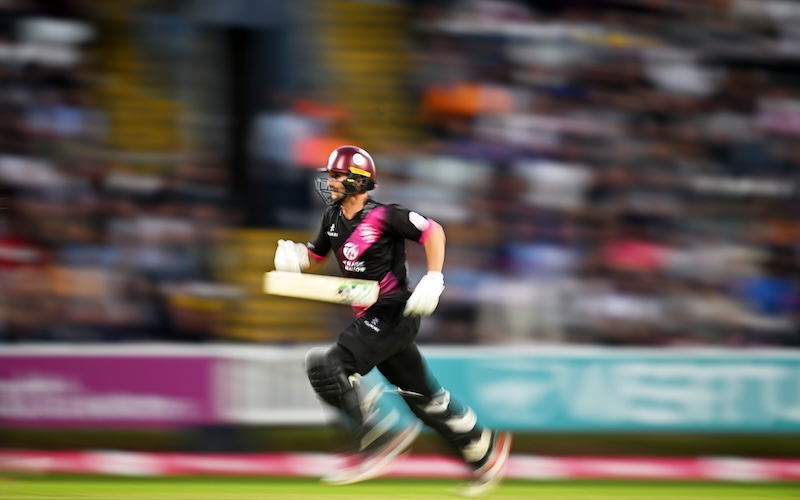The Vertu Motors Cricket A-Z
10/07/2024 12:00
Share
The Vertu Motors Cricket A-Z
The County Championship and Vitality Blast campaigns are now well underway, with Vertu Motors once again throwing its support behind three teams chasing glory in all formats of the game.
With regular updates from Nottinghamshire, Somerset and Yorkshire featuring on the newsroom as the season pans out, we thought it might be useful to provide a quick guide to some cricket terms that may prove to be useful...
A is for...ALL-ROUNDER
An all-rounder is a cricketer who is adept at multiple elements of the game, so is more than just a specialist with either the bat or ball. The all-rounder can be a crucial part of the line-up because of their ability to carry out more than one role on the pitch, providing back up for the specialist bowlers or being relied upon to add more runs with bat that you would expect from a specialist bowler in the lower order.
B is for...BOUNDARY
The boundary is the outer perimeter of the pitch and marked out with the use of a rope. If a batsman hits a shot that goes beyond the boundary without bouncing, then six runs are scored. Should the ball bounce before passing the boundary mark, then four runs are awarded.
C is for...CREASE
The crease is the area directly in front of the wicket where the batsman stands to receive the ball. When a batsman is in the crease with their bat on the floor, or has completed a run and grounded their bat in the crease, then they are safe from being stumped or run out. When a bowler is running in from the other end to make their delivery, they must not overstep the crease, or a no-ball will be called.
D is for...DRAW
Unlike football or rugby, a draw in cricket isn’t when the scores are level; that is referred to as a tie. A draw in cricket occurs in longer formats of the game and comes when the team that is batting last, and is therefore chasing a target, fails to reach that score before the time allotted has expired but still has wickets in hand. As an example, if a team was set 250 runs to win and had only reached 200 for the loss of six wickets when the final day of play came to an end, the game would be drawn.
E is for...EDGE
Edge is the term used when a bowler delivers a ball that flicks off the edge of the bat when the batsman attempts to play a shot. ‘Edging’ a shot to a nearby fielder is a common way in which a batsman may be dismissed during a match.

F is for...FOLLOW ON
The follow on is a target set for the team batting second in the first innings, and if they fail to hit that target, they can be forced to immediately start their second innings. With County Championship matches running over four days, the follow-on can be enforced if a team fails to get to within 150 runs of the team batting first.
As an example, if the team batting first scores 400 runs and the team batting second only reaches 200, then they can be forced to follow on. If that team then surpasses the 400 runs scored by the opposition then they will be setting a target to be chased, but if they were to be bowled out for less than 200 (so a combined total of 400 runs) then they would lose the game by an innings.
G is for...GOOGLY
The googly is a ball that is bowled by a leg-spinner, who would traditionally bowl a ball that that turns away a right-handed batsman - so pitching from right to left as the bowler sees it. The googly however is a delivery that is disguised by the bowler and instead turns to the other way in an attempt to deceive the batsman.
H is for...HAT-TRICK
A hat-trick is when a bowler takes three wickets with three successive deliveries. Those three deliveries don’t have to be in the same over, and could even stretch across two innings if a bowler was to take the final two wickets in one, and then took a wicket with their first ball of the next.
I is for...INNINGS
Each team will bat twice during a match in the County Championship, with each time a team goes in to bat being called an innings. In the Vitality Blast and One Day Cup, games comprise of a single innings or a set number of overs.
J is for...JAFFA
A jaffa is a delivery from a bowler that is particularly good, and which will usually be unplayable from the batsman’s perspective.
K is for...KNOCK
An informal term for the inning played by a batsman.

L is for...LBW
Leg Before Wicket – abbreviated to LBW – is a common way for a batsman to be dismissed, and comes when the ball hits the batsman on the leg before the bat, and would have gone on to strike the wicket.
M is for...MAIDEN
A maiden is an over when a bowler concedes no runs, either via the batsman or through any extras.
N is for...NIGHTWATCHMAN
The nightwatchman is a lower order batsman, usually a bowler, who is sent out at the end of the day in the event of a dismissal to prevent a more valuable batman having to face a handful of deliveries. The nightwatchman won’t be expected to contribute a large number of runs to the total but instead, just see out the remaining balls or overs in an evening.
O is for...OVER
An innings in cricket comprises of overs – a delivery of six consecutive balls by one bowler. Two bowlers will be put in bowl their overs at the same time from opposite ends of the ground.
P is for...PLAYING ON
Playing on is when a batsman goes to play a shot but can only divert the ball on to the stumps..
Q is for...QUOTA
Quota is the amount of overs that a bowler is allowed to bowl during a Vitality Blast or One Day game.
R is for...RUN RATE
The run rate is the average number of runs scored per over during an innings
S is for...STUMP
Stump can be used in a number of ways during a game of cricket. In the first instance, the stumps are the three posts that the bowler aims to hit, and which the batsman is trying to defend. In the second, stump is a way in which the batsman can be dismissed by the wicket-keeper if they have left their crease whilst attempting a shot. The third is when play ends for the day, it is referred to as ‘stumps’.

T is for...T20
T20 is the shorter form of the game comprising of a single, twenty over innings for each team – designed to broaden the appeal to the sport to a wider audience.
U is for...UMPIRE
The umpire is the referee when it comes to cricket, and is there to enforce the rules of the game. Two umpires can be found on the field of play, with one at each end, whilst a third umpire may be found off the field to adjudicate on decisions that require a video replay.
V is for...V
The V is the area of the pitch that arcs out from the wicket either side of the bowler through fielding positions known as mid-off and mid-on. Playing a shot ‘in the V’ means hitting it straight back down the ground past the bowler, with such shots often making it to the boundary.
W is for...WICKET
Wicket is another term that can have different meanings, with the most common being the set of three stumps and two bails located at each end of the pitch. The pitch itself can also be referred to as the wicket, whilst when a batsman is dismissed it is said that his wicket has fallen.
X is for...X-FACTOR
The X-Factor never featured in the English game and was instead a short-lived initiative introduced into the Big Bash League – a T20 competition run in Australia. The X-Factor allowed teams to bring on a substitute player at the ten over mark as long as the player being replaced hasn’t yet batted or bowled more than one over.
Y is for...YORKER
A yorker is a delivery bowled by a fast bowler that is pitched close to the batsman, with the idea that is hits the ground underneath the bat and near to the toes – making it difficult to play a shot.
Z is for...ZOOTER
The zooter is a ball that is bowled by a leg spin bowler, who bowls deliveries that go from the leg side of a batsman (the rear) to the off side (the front). Where the zooter differs is that the delivery is bowled with little or no spin, and with very low bounce, so that it ‘zoots’ along the pitch and is more difficult for the batsman to play.